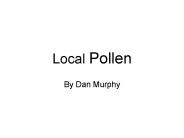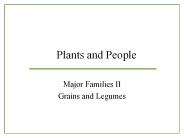Stamens PowerPoint PPT Presentations
All Time
Recommended
'Geranium; flowers 5-merous, stamens with filaments united at base; fruit with ... GUIDE TO FLOWERING PLANT RECOGNITION (Phylogenetic System of Classification) ...
| PowerPoint PPT presentation | free to view
Perfect vs. imperfect flowers. Stamenate vs. carpellate ... Utilize 'dichogamy' stamens and carpels mature at different times. Protandrous: stamens first ...
| PowerPoint PPT presentation | free to view
Bisexual flowers have both male (stamens) and female (carpels) reproductive ... Incomplete flowers lack one or more of the following: sepals, petals, stamens or ...
| PowerPoint PPT presentation | free to view
Complete: all 4 floral organs (floral organs: sepals, petals, stamens ... Incomplete: lacking 1 or more floral. Perfect: both stamens and carpels on 1 flower ...
| PowerPoint PPT presentation | free to view
Chapter 38 Chapter 38 ~ Plant Reproduction and Development Floral variations Floral organs: sepals, petals, stamens (male ), carpels (female) complete: all 4 ...
| PowerPoint PPT presentation | free to view
from purple flower. Transferred sperm- bearing pollen from. stamens of white. flower to egg ... purple flower. Carpel. Stamens. Parental. generation (P) ...
| PowerPoint PPT presentation | free to view
... Stamens, composed of anther organ that ... for the embryo to grow Mature ovule becomes the seed coat and/or fruit Monocot vs. Dicot Angiosperms are ...
| PowerPoint PPT presentation | free to download
The Parts of. the Flower. stigma. style. ovary. ovules. carpel. anthers. filaments. stamens. petal. corolla. sepal. calyx. receptacle. penduncle ...
| PowerPoint PPT presentation | free to download
Introduced to Africa from Americas from Fernando Po and by missionaries ... Hermaphrodite. Stamens(5) are fertile, 5 are staminodes( sterile) Pollination ...
| PowerPoint PPT presentation | free to view
Has been in the past, not competitive, long growing season, mealy bugs ... Individual flower hermaphrodite, 6 stamens (2 whorls of 3) ...
| PowerPoint PPT presentation | free to view
reproduction in seed plants ch.24 complete (perfect) flowers complete flowers have 4 typical flower parts: stamens, pistils, sepals, and petals.
| PowerPoint PPT presentation | free to download
After removing the stamens I made s by rubbing them in glycerine. ... Surprisingly my best samples came from an unlikely source. ...
| PowerPoint PPT presentation | free to download
calyx (4 sepals), corolla (4 petals), androecium, 6 stamens, gynoecium, 2 carpels. ... an alteration DNA sequence such that the genotype of subsequent individuals ...
| PowerPoint PPT presentation | free to download
We offer Custom Collection Jewelry for Party Wear. Each piece made in house at time of purchase. Made in limited quantities the concept of these pieces are to share a bigger story and a lager stamens than the jewelry itself.
| PowerPoint PPT presentation | free to download
serve as bridal beds which the Creator has so gloriously ... and wife have the same bed) [Hermaphrodite flowers: stamens and pistils in the same flower] ...
| PowerPoint PPT presentation | free to download
Hermaphrodite -- bisexual flower with both stamens and pistil ... Hermaphrodite -- the plant has ... Gynodioecious -- has both female and hermaphrodite plants ...
| PowerPoint PPT presentation | free to view
Flower emerge in autumn. Three yellow stamens which not produce viable spores ... Flower has six petals. Saffron has not true stem ...
| PowerPoint PPT presentation | free to view
Female carpels Male stamens. Dioecious- these flowers are on different plants. Carpellate Staminate. Natural vegetative reproduction. Kalanchoe Aspen. Teosinte Maize ...
| PowerPoint PPT presentation | free to download
... Solanaceae 1. Leaves alternate; stipules absent. 2. Flowers actinomorphic. 3. Stamens 5-merous; ovary 2 locular. 4. Ovaries numerous. 5.
| PowerPoint PPT presentation | free to view
Types of Flowers. complete. contains 4 main parts. Incomplete. does not have all 4 main parts ... Types of Flowers. monoecious. stamens and pistils are found ...
| PowerPoint PPT presentation | free to view
To familiarize you with vegetative and floral morphology of 2 families ... Perianth (calyx corolla) As lodicules at the base of the ovary. Stamens ...
| PowerPoint PPT presentation | free to view
Types of Flowers. complete. contains 4 main parts. Incomplete. does not have all 4 main parts ... Types of Flowers. monoecious. stamens and pistils are found ...
| PowerPoint PPT presentation | free to view
Note: this is a perfect flower, i.e., with both male and ... (Salvia leucophylla) Monocotyledon flower: 6 (2 X 3) tepals, 6 stamens (Hesperoyucca whipplei) ...
| PowerPoint PPT presentation | free to view
Genetics the study of heredity that deals with the transmission of traits from ... has male (stamens) and female (carpal) sexual organs) allows self-fertilization ...
| PowerPoint PPT presentation | free to view
... monocots and dicots, angiosperms and gymnosperms, and vascular ... 2. Which process is prevented from occurring when stamens are removed from an angiosperm? ...
| PowerPoint PPT presentation | free to view
Angiosperms flowering plants (largest phylum of living plants) Monocots flowering plants that have a single ... Stamens pollen bearing part of a flower ...
| PowerPoint PPT presentation | free to view
Stamens. Male reproductive structure. Carpels. Female reproductive structure. The Flower. Stamen. Filament. Anther. Pollen grains (male gametophyte) develop here ...
| PowerPoint PPT presentation | free to view
... use principles of plant genetics to guide their plant breeding programs? ... A flower that has both stamens (male reproductive tissues) and a carpel (female ...
| PowerPoint PPT presentation | free to view
A flower that has all four major flower parts: Pistil, Stamen, Calyx, Corolla. Complete Flowers ... Calyx: all the sepals. Corolla: all the petals. Stamens ...
| PowerPoint PPT presentation | free to view
perfect: both stamens and carpels on 1 flower. imperfect: lacking either a stamen or carpel. monoecious: staminate and carpellate flowers on 1 plant) ...
| PowerPoint PPT presentation | free to view
Plants are able to detect the time of the year or seasons by using the ... floral organs activate and form the organs (sepal, petals, stamens and carpels) ...
| PowerPoint PPT presentation | free to view
PUMPKIN. Large and produces pistil and stamens. Grows in sheltered and warm vegetable patches ... Related to cucumbers and melons. Mashed Zucchini. 2-3 ...
| PowerPoint PPT presentation | free to download
April 26. April 4. April 16. April 24. CORPSE FLOWER- Kew Gardens. April 29. April 30. May 2. May 1. May 3. May 5. fruit. Male flowers (stamens) Female flowers ...
| PowerPoint PPT presentation | free to view
Only Crocus Sativus provides SAFFRON • A delicate highly valued spice, with very interesting medical properties, prescribed in Homeopathy • Saffron provides taste and it a powerful dye • It is a corm planted at 15cm depth, multiplying yearly and produces new corms • Crocus Sativus is a sterile plant, therefore for over 3000 years pure • Crocus Sativus has a reversed vegetation cycle, leaves come out in September and the plant flowers in October, and dries up in May-June next year • Saffron flower is composed 6 (Six) Petal’s ,3 (three) golden Stamens and one red pistil (joined with 3 Stigmas • It is this pistil made up of 3 stigmas which when dried up gives the spice saffron
| PowerPoint PPT presentation | free to download
One Word Who am I? Photos (describe the family also) More Photos Lots of Photos 5 pt 5 pt 5 pt 5 pt 5 pt 10 pt 10 pt 10 pt 10 pt 10 pt 15 pt 15 pt 15 pt 15 pt 15 pt
| PowerPoint PPT presentation | free to download
What Do You Need to Root the Network? You need an outgroup. Outgroups are assumed to have separated from the ingroup lineage before the ingroup diversified; i.e., the ...
| PowerPoint PPT presentation | free to download
Field Characteristics of Common Plant Families in New Mexico
| PowerPoint PPT presentation | free to view
Ericaceae -- the heather or blueberry family (116+/3,500; cospmopolitan) Dilleniidae Habit herbs, shrubs, or trees; often with evergreen leaves, some members (e.g ...
| PowerPoint PPT presentation | free to download
Everything you need to know about flowers! Ann Morris, Science Advisory Teacher, PPEC, 29.4.02
| PowerPoint PPT presentation | free to download
Sexual Reproduction in Plants C10L3P2 monoecious plant any plants on which staminate and pistillate flowers are produced (oaks, walnuts, hickories, birches) dioecious ...
| PowerPoint PPT presentation | free to download
... use the wind, insects, bats, birds and mammals to ... The carpel enlarges to form the flesh of the fruit and to protect the ovary. Wind pollination ...
| PowerPoint PPT presentation | free to download
Lesson 1 Examining Parts of a Flower Student Learning Objectives 1. Describe the parts of a flower. 2. Identify the reproductive structures of plants that exist in ...
| PowerPoint PPT presentation | free to view
Plants and People Major Families II Grains and Legumes Why grains and legumes? And why together? Grain + legume = complete protein That peanut butter sandwich is ...
| PowerPoint PPT presentation | free to view
THE FLOWER Packet #74 Chapters 30 & 38 THE PETALS * * Petals are often brightly colored and of various shapes Aid in attracting pollinators Also considered sterile ...
| PowerPoint PPT presentation | free to download
Rosaceae -- the rose family (100/3000; Cosmopolitan, most common in temperate \subtropical N. Hemisphere) Rosidae Habit trees and shrubs, rarely herbs, usually armed
| PowerPoint PPT presentation | free to download
There is an amazing diversity of floral structures. ... In general flowers were diverse in the number of floral parts and in their arrangements. ...
| PowerPoint PPT presentation | free to download
Flowers: actinomorphic to slightly zygomorphic, perfect, hypogynous, showy ... Flowers: 'strikingly' zygomorphic, perfect, epigynous, very small to large and showy ...
| PowerPoint PPT presentation | free to view
Aceraceae -- the maple family (2/120; Mostly New and Old World temperates, plus tropics of s.e. Asia) Rosidae II Habit shrubs or trees Leaves palmately-veined, simple ...
| PowerPoint PPT presentation | free to download
Flowers are composed of 4 main parts arranged in concentric ... Home to the anther and filament. This is where pollen is collected. 10/6/09. Parts of a Flower ...
| PowerPoint PPT presentation | free to view
Hypanthium. stipules. Ranunculaceae 3,5- , ,3- No hypanthium. no stipules ... no hypanthium. From http://www.wisc.edu/ botit/img/bot/130/Angiosperm ...
| PowerPoint PPT presentation | free to view
Families Part III ... 3 defining characteristics from other members of the plant ... species Includes world s smallest flowering plant Species ...
| PowerPoint PPT presentation | free to view
Plants and People Flowers Why a Flower? The Reproductive Structure of Flowering Plants: Flower Anatomy Flower Anatomy Flower Anatomy Flower Anatomy Flower Anatomy ...
| PowerPoint PPT presentation | free to view
Welcome to our tour
| PowerPoint PPT presentation | free to view
Irregular Flowers ... separate male and female flowers. ... Nectar guides absent. Nectar guides present. Unscented flowers. Scented flowers. Nectaries absent ...
| PowerPoint PPT presentation | free to view
Chapter 3 BOT3015L Biology of Flowering Plants: Reproduction Flowers and Pollination Presentation created by Danielle Sherdan All photos from Raven et al. Biology of ...
| PowerPoint PPT presentation | free to view
Plant Reproduction Asexual and Sexual (yes, sexual!) Asexual Reproduction Most plants reproduce asexually Does not require fertilization faster and requires less ...
| PowerPoint PPT presentation | free to view
























































